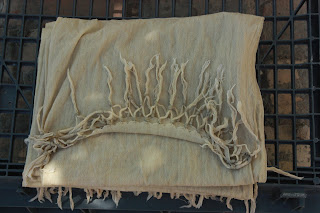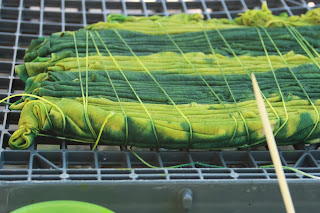I am making a demo doll to show people about babywearing. Since sometimes toddlers have their own opinions and don't cooperate or else don't fit in carries better suited for little bitties.
Loads of people on TBW have made dolls by buying a plastic doll and filling it with something heavy like bbs, but I don't have that kind of resources at my beck and call. I do, however, have a ton of fabric and am surrounded by rocks. I even have some stuffing. I've made a doll before. This can't be too hard, right??
I first went and filled up a container with sand/gravel from the arroyo. I weighed it on our bathroom scale and it came out to about 7 and a half pounds. I know people have said that the dead weight of a doll can be a lot heavier than the real baby, so I am not going to collect 30 lbs of gravel. But I did fill up the container twice. I am planning on having the main portion of the weight (and also firmness) in the body of the doll, with a bit in the arms and legs so that they are easy to find while wrapping and simulate the way real arms and legs would respond to seat making and gravity. I will add just a bit of weight to the head so the doll isn't just a fluff-brain, but I don't want to have a floppy headed newborn doll, so I will have to keep it minimal.
I started out by stitching up little hands from the skin-toned interlock. Then I filled them with fluff and sewed them shut at the openings. I stitched these into the ends of the sleeves. From another knit fabric scrap, I created a narrow tube just less long than the sleeve for the gravel-sand to go into. I used a bit of stuffing to make a softer place where the elbow joint will be. Then I slid the sandbags into the sleeves and surrounded by fluff to make them less like weapons. Originally I had put the rocks in little plastic sandwich baggies and taped them shut, but it made the arms really crackly, and not so nice. Finished off the ends of the arms so they were ready to sew onto the body.
Next I sewed up a little packet of rocks, like an envelope or rectangular bean bag. I have it partway in the head and partway in the shoulders to give the neck stability, since I want a doll with good head control. I made up a knit tube to the diameter of the head, bound off one end with artificial sinew, turned it right-side out, and I stuffed the top of it with fluff, then inserted the rock packet into the neck. Around the neck, I tightly tied a few rounds of artificial sinew to hold the head/neck fabric tight to the packet.
For the body, I sewed up a tube with seat darts to create a bottom. To it I stitched the arms. Then I filled the body with gravel, and inserted the head/neck/shoulders into the body cavity to give the neck some stability. I surrounded the shoulders by more rocks and a little bit of stuffing at the very end for easier sewing. I sewed the head and body together using a ladder stitch.
I sewed more tubes like those for the arm weights in the right proportions for some chunky thighs and feet. I filled the legs out in the same way as the arms, only I made them more flexible at the knee so they could illustrate a nice, deep seat. The feet were sewn at an angle using the ladder stitch so that they stay flexed, and the knees have a wee bit of bend, too. Once the legs were filled and closed off, I stitched them on at the bottom of the onesie, so that the doll would have its feet out in front in a seated position.
I stitched on little green embroidery thread eyes and a little mouth so as to make it less creepy, added a hat to cover the gathered head, and the last thing was just to dress the doll in some old clothes, and call it a day!
He weighs 13 lbs and is about 25" long. And he is a very cooperative wrappee. I'm having fun making babywearing tutorials over at suncitybabywearing.wordpress.com
*Over a few uses, the rocks have really started to settle in the body. Before long, I may need to add some more to fill out the shoulders again. This may have been avoidable had I thumped the gravel-filled body on the table a few times to get all the excess spaces out, but it didn't occur to me.






















































